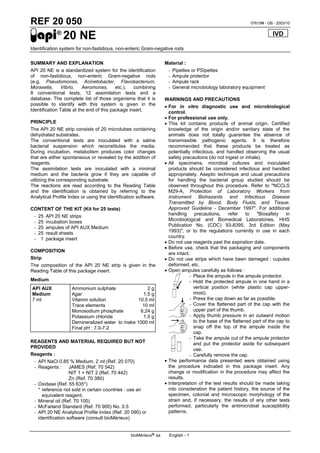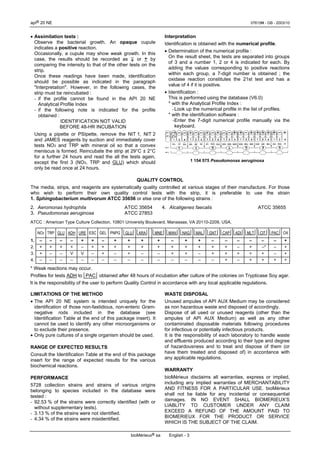The document provides instructions for using the API 20 NE identification system to identify non-fastidious, non-enteric Gram-negative rods. The system consists of 20 microtubes containing dehydrated substrates that are inoculated with bacterial samples. During incubation, the samples metabolize the substrates, producing color changes that are read to determine reactions and identify the bacteria based on the profile. The instructions describe preparing samples, inoculating the strips, incubating, reading the results, and interpreting the identification profile.

![api® 20 NE 07615H - GB - 2003/10
bioMérieux® sa English - 2
STORAGE CONDITIONS
The strips and media should be stored at 2-8°C until the
expiration date indicated on the packaging.
SPECIMENS (COLLECTION AND PREPARATION)
API 20 NE is not for use directly with clinical or other
specimens.
The microorganisms to be identified must first be iso-
lated on a suitable culture medium (e.g., Trypticase Soy
agar) according to standard microbiological techniques.
INSTRUCTIONS FOR USE
Oxidase test
The oxidase test must be performed according to the
manufacturer's instructions for use. The result should be
recorded on the result sheet as it is an integral part of the
final profile (21st identification test).
Selection of colonies
API 20 NE should only be used with non-fastidious Gram-
negative rods which do not belong to the Entero-
bacteriaceae.
NOTE 1 : Some non-enteric Gram-negative rods are
oxidase negative (S. maltophilia, Acinetobacter...). These
microorganisms may also be identified with API 20 NE but
their selection must be based on other bacteriological or
clinical criteria.
NOTE 2 : Fastidious organisms having demanding
nutritional requirements and requiring appropriate
handling precautions (i.e. Brucella and Francisella) are
not included in the API 20 NE database. Alternative
procedures must be used to exclude or confirm their
presence.
Preparation of the strip
• Prepare an incubation box, tray and lid, and distribute
about 5 ml of distilled water or demineralized water
[or any water without additives or chemicals which may
release gases (e.g. Cl2, CO2, etc.)] into the bottom of the
tray to create a humid atmosphere.
• Record the specimen number on the elongated flap of
the tray. (Do not record the number on the lid as it may
be misplaced during the procedure.)
• Remove the strip from its individual packaging.
• Place the strip in the incubation box.
Preparation of the inoculum
• Open an ampule of API NaCl 0.85 % Medium (2 ml) as
indicated in the paragraph "Warnings and Precautions"
of the package insert for this product, or use any tube
containing 2 ml of 0.85 % physiological saline without
additives.
• Using a pipette or PSIpette, pick up 1-4 colonies of
identical morphology from the agar plate, either by
suction or by successive touches. It is recommended to
use young cultures (18-24 hours old).
• Prepare a suspension with a turbidity equivalent to
0.5 McFarland. This suspension must be used
immediately after preparation.
NOTE : It is very important that the density of the
inoculum be adjusted to 0.5 McFarland ; the API 20 NE
strip tests may otherwise not function correctly. In
particular, a weaker inoculum may lead to false negative
results. Do not touch the cupules while working with the
strip and do not leave the strip exposed to air for a long
period of time after inoculation.
Inoculation of the strip
• Inoculate tests NO3 to PNPG by distributing the saline
suspension into the tubes (and not the cupules) using
the same pipette. To avoid the formation of bubbles at
the base of the tubes, tilt the strip slightly forwards and
place the tip of the pipette or PSIpette against the side
of the cupule.
• Open an ampule of API AUX Medium as indicated in the
paragraph "Warnings and Precautions" and add
approximately 200 µl of the remaining saline suspension
to the ampule. Homogenize well with the pipette,
avoiding the formation of bubbles.
• Fill the tubes and cupules of tests GLU to PAC with
the suspension. Take care to leave a flat or slightly
convex, but not concave, meniscus. Cupules under or
overfilled may give incorrect results.
• Add mineral oil to the cupules of the 3 underlined tests
(GLU, ADH and URE) until a convex meniscus is
formed.
• Close the incubation box and incubate at 29°C ± 2°C for
24 hours (± 2 hours).
READING AND INTERPRETATION
Reading the strip
• After the incubation period, read the strip by referring to
the Reading Table.
• Record all spontaneous reactions (GLU, ADH, URE,
ESC, GEL and PNPG) on the result sheet.
• The reading of the two tests NO3 and TRP should be
performed whilst protecting the assimilation tests from
airborne contamination. To do this, cover the
assimilation tests with the incubation box lid during the
reading of the NO3 and TRP tests.
• NO3 test :
- Add 1 drop of NIT 1 and 1 drop of NIT 2 reagents to
the NO3 cupule.
- After 5 minutes, a red color indicates a positive
reaction to be recorded on the result sheet.
- A negative reaction may be due to the production of
nitrogen (indicated by the presence of tiny bubbles) :
add 2-3 mg of Zn reagent to the NO3 cupule.
- After 5 minutes, a cupule remaining colorless
indicates a positive reaction to be recorded on the
result sheet. If the cupule turns pink-red, the reaction
is negative as nitrates were present in the tube and
were reduced to nitrite by the zinc.
The reaction used for the identification of the bacterium
is the reduction of nitrates. It is positive when either of
the above reactions (production of NO2 or N2) is
positive.
The production of N2 may, however, be useful alone as
a supplementary test (refer to the Analytical Profile
Index).
• TRP test :
Add 1 drop of JAMES reagent. The reaction takes place
immediately : a pink color which develops in the whole
cupule indicates a positive reaction to be recorded on
the result sheet.](https://image.slidesharecdn.com/api20ne1-110507170426-phpapp02/85/Api20-ne-1-2-320.jpg)

